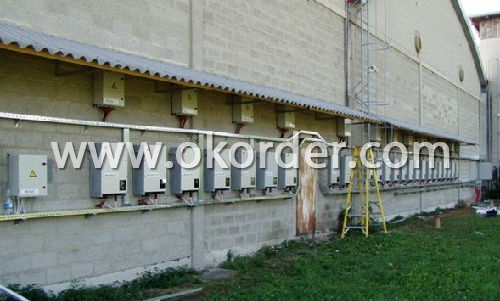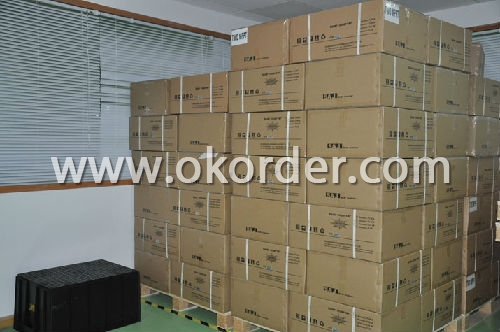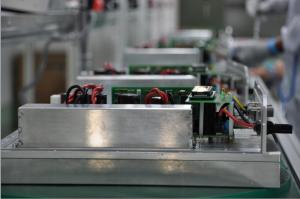Grid Tied Solar Inverter 3-Phase CNBM-12000UE
- Loading Port:
- NanJing
- Payment Terms:
- TT
- Min Order Qty:
- 1 set set
- Supply Capability:
- 1000 per month set/month
OKorder Service Pledge
OKorder Financial Service
You Might Also Like
Features of Grid Tied Solar Inverter 3-Phase CNBM-12000UE
With a R&D team more than 100 engineers,40% of the staff, who has been deeply engaged in the photovoltaic industry for 10 years, CNBM takes the mission to increase the inverter availability and efficiency, putting continuous innovation to make CNBM inverter easier for installation and operation, and more cost-effective for solar plant construction. The full range of CNBM single phase inverters has received VDE, CE, G83/1, G59/2, ENEL2010, VDE4105, C10/C11, AS4777 etc.
The Grid Connected Solar Inverter we can offer is 1.5kw to 20kw.
Introduction of Grid Tied Solar Inverter 3-Phase CNBM-12000UE
Maximum efficiency of 97.8% and wide input voltage range
Integrated DC switch-disconnected
MTL-String
Sound control
Bluetooth/RF technology /Wi-Fi
Transformerless GT topology
5 years warranty (10 years as optional)
Technical data of Grid Tied Solar Inverter 3-Phase CNBM-12000UE
Model | CNBM-10000UE | CNBM-12000UE | |
Input data (DC) |
|
| |
Max. DC power | 10500W | 12500W | |
Max. DC voltage | 1000V | 1000V | |
Start voltage | 350V | 350V | |
PV voltage range | 180V-1000V | 180V-1000V | |
Max. input current | 15A | 17A | |
Number of MPP trackers /strings per MPP tracker | 2/2 | 2/2 | |
Output (AC) |
| ||
Rated AC output power | 10000W | 12000W | |
Max. AC power | 10000VA | 12000VA | |
Max. output current | 16A | 19A | |
Power factor | 1 | 1 | |
THDI | <3% | <3% | |
AC connection | Three phase | Three phase | |
Efficiency |
| ||
Max. efficiency | 98% | 98% | |
Euro weighted efficiency | 97.5% | 97.5% | |
MPPT efficiency | 99.5% | 99.5% | |
Protection devices |
| ||
Output over voltage protection-varistor | yes | yes | |
Ground fault monitoring | yes | yes | |
Grid monitoring | yes | yes | |
General Data |
| ||
Dimensions (W / H / D) in mm | 740/440/235 | 740/440/235 | |
Weight | 41KG | 41KG | |
Operating temperature range | –25°C ... +60°C | –25°C ... +60°C | |
Altitude | 2000m(6560ft) without derating | ||
Self-Consumption night | < 0.5 W | < 0.5 W | |
Topology | Transformerless | ||
Cooling concept | Natural | Natural | |
Environmental Protection Rating | IP65 | IP65 | |
Features |
| ||
DC connection | H4/MC4(opt) | H4/MC4(opt) | |
Display | LCD | LCD | |
Interfaces: RS485/RS232/Bluetooth / RF/Zigbee/Wifi | yes/yes/opt/opt/opt | ||
Warranty: 5 years / 10 years | yes /opt | ||
Certificates and approvals | CE、VDE 0126-1-1、DK5940、G83/1-1、G59/2、RD1663、EN50438、 VDE-AR-N4105、CEI-021、IEC-62109、ENEL-Guide | ||
Grid Tied Solar Inverter 3-Phase CNBM-12000UE is simple national setting of line supply monitoring, Easy country configuration, with Multi-language,display, currently available for most of the countries over the world.With technical creativity and scientific management, the factory established first class R&D and test centers, as well as management and R&D teams comprising of PhDs and masters with overseas qualification.
Figure 1 the application of Grid Tied Solar Inverter 3-Phase CNBM-12000UE

Figure 2 The Stock of Grid Tied Solar Inverter 3-Phase CNBM-12000UE

- Q:How does a solar inverter handle variations in solar panel tilt and orientation?
- A solar inverter handles variations in solar panel tilt and orientation by continuously monitoring the output voltage and current of the solar panels. It then adjusts the power conversion process to optimize the efficiency of power generation based on the tilt and orientation of the panels. This ensures that maximum power is extracted from the solar panels regardless of their position, allowing for optimal energy production.
- Q:Can a solar inverter be monitored remotely?
- Yes, a solar inverter can be monitored remotely. With the help of advanced technologies and internet connectivity, solar inverters can be connected to a monitoring system that allows real-time monitoring and control from a remote location. This remote monitoring feature enables users to track the performance, energy production, and potential issues of their solar inverters without being physically present at the installation site.
- Q:Can a solar inverter be used with solar trackers?
- Yes, a solar inverter can be used with solar trackers. Solar trackers are designed to follow the sun's movement throughout the day, maximizing the solar panel's exposure to sunlight. The solar inverter converts the DC (direct current) power generated by the solar panels into AC (alternating current) power that can be used in homes or businesses. The inverter can be connected to the solar tracker system to ensure efficient and effective utilization of the solar energy harvested by the panels.
- Q:How does a solar inverter convert DC power to AC power?
- A solar inverter converts DC power to AC power by utilizing a two-step process. First, it converts the DC power generated by the solar panels into a high-frequency AC current. Then, it uses a transformer to increase the voltage and shape the AC waveform to match the grid's requirements. This process allows the solar energy to be fed into the electrical grid or used directly in homes and businesses.
- Q:How does a solar inverter synchronize with the grid?
- A solar inverter synchronizes with the grid by constantly monitoring the grid's frequency and voltage. It adjusts its own output frequency and voltage to match the grid's, ensuring that the solar energy it produces is in sync with the electricity supplied by the grid. This synchronization process allows the solar inverter to safely and efficiently inject solar power into the grid, while also allowing for seamless transition between solar and grid power.
- Q:What are the key factors affecting the lifespan of a solar inverter?
- The key factors affecting the lifespan of a solar inverter are the quality of components used, the level of maintenance and care, the operating environment, and the overall design and build quality of the inverter.
- Q:How does a solar inverter handle islanding detection?
- A solar inverter handles islanding detection by constantly monitoring the grid voltage and frequency. If the solar inverter detects a deviation from the normal grid parameters, it will automatically disconnect from the grid to prevent islanding.
- Q:How does a microinverter differ from a string inverter?
- A microinverter differs from a string inverter in that it is a small, individual inverter attached to each solar panel, converting the DC power generated by the panel into AC power. On the other hand, a string inverter is a larger central inverter that is connected to multiple solar panels in a string, converting the combined DC power into AC power. The main advantage of a microinverter is that it allows for maximum power point tracking and independent operation of each panel, increasing the overall efficiency and output of the solar system. Additionally, microinverters provide monitoring capabilities at the panel level, making it easier to identify and address any issues or malfunctions.
- Q:How does a solar inverter communicate with monitoring systems?
- A solar inverter communicates with monitoring systems through various means such as wireless technologies like Wi-Fi, Bluetooth, or Zigbee, or through wired connections like Ethernet or RS485. These communication channels allow the inverter to transmit important data and performance metrics to the monitoring systems in real-time.
- Q:Can a solar inverter be used with a solar-powered electric vehicle charging station?
- Yes, a solar inverter can be used with a solar-powered electric vehicle charging station. The solar inverter converts the DC (direct current) electricity generated by the solar panels into AC (alternating current) electricity, which is required to charge an electric vehicle. By using a solar inverter, the solar-powered electric vehicle charging station can efficiently convert and deliver the electricity generated from solar panels to charge electric vehicles.
1. Manufacturer Overview |
|
|---|---|
| Location | Hefei,China |
| Year Established | 2004 |
| Annual Output Value | Above US$0.6 billion |
| Main Markets | Australia;Italy;Germany;U.K. England;Franch;NewZealand; |
| Company Certifications | Growatt5000;VDE0126;SAA;G83;TUV |
2. Manufacturer Certificates |
|
|---|---|
| a) Certification Name | |
| Range | |
| Reference | |
| Validity Period | |
3. Manufacturer Capability |
|
|---|---|
| a)Trade Capacity | |
| Nearest Port | Shenzhen |
| Export Percentage | 0.4 |
| No.of Employees in Trade Department | 10 People |
| Language Spoken: | English;Chinese;French;German |
| b)Factory Information | |
| Factory Size: | Above 15,000 square meters |
| No. of Production Lines | Above 5 |
| Contract Manufacturing | OEM Service Offered;Design Service Offered |
| Product Price Range | Average |
Send your message to us
Grid Tied Solar Inverter 3-Phase CNBM-12000UE
- Loading Port:
- NanJing
- Payment Terms:
- TT
- Min Order Qty:
- 1 set set
- Supply Capability:
- 1000 per month set/month
OKorder Service Pledge
OKorder Financial Service
Similar products
New products
Hot products
Related keywords





























